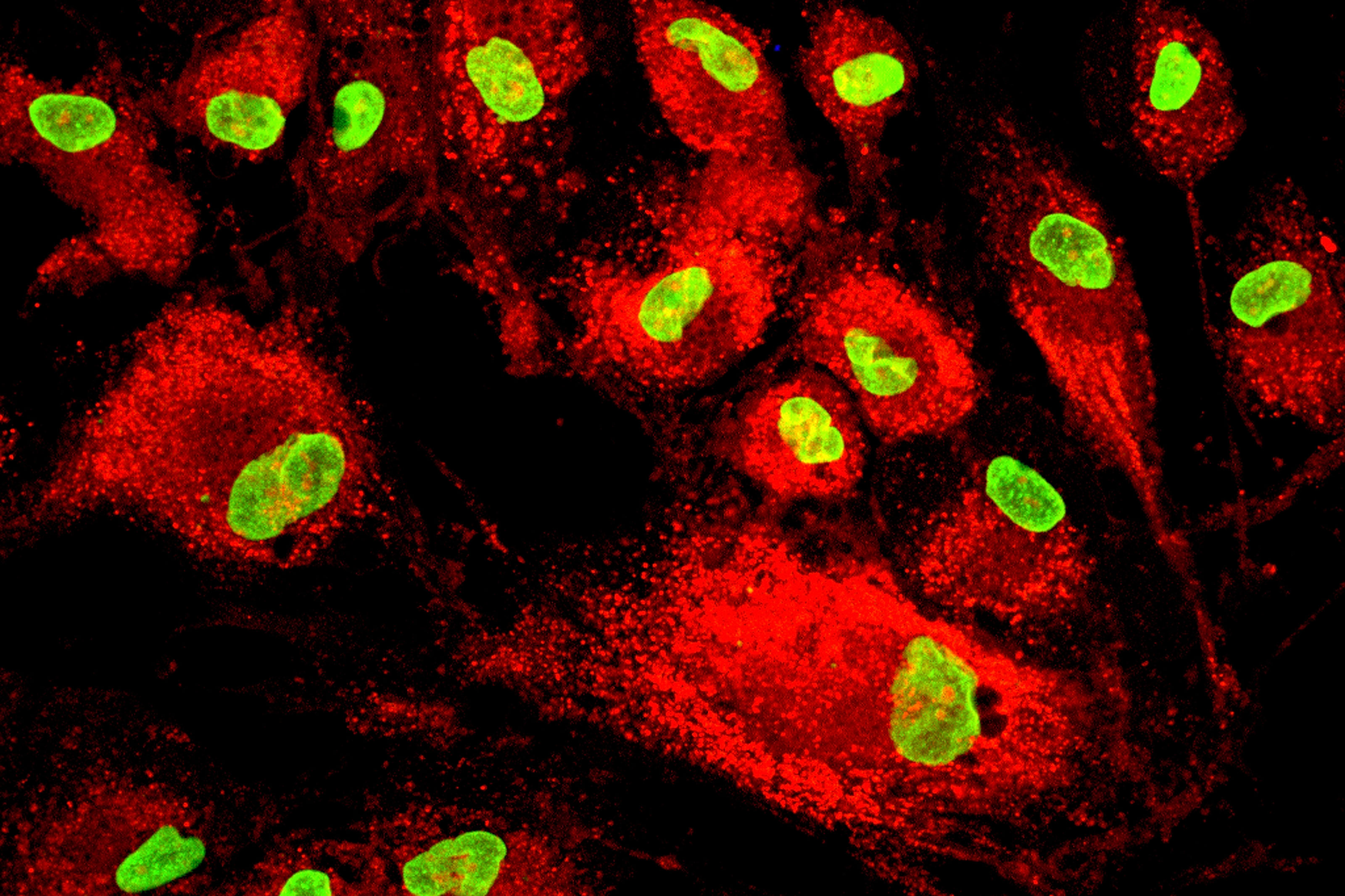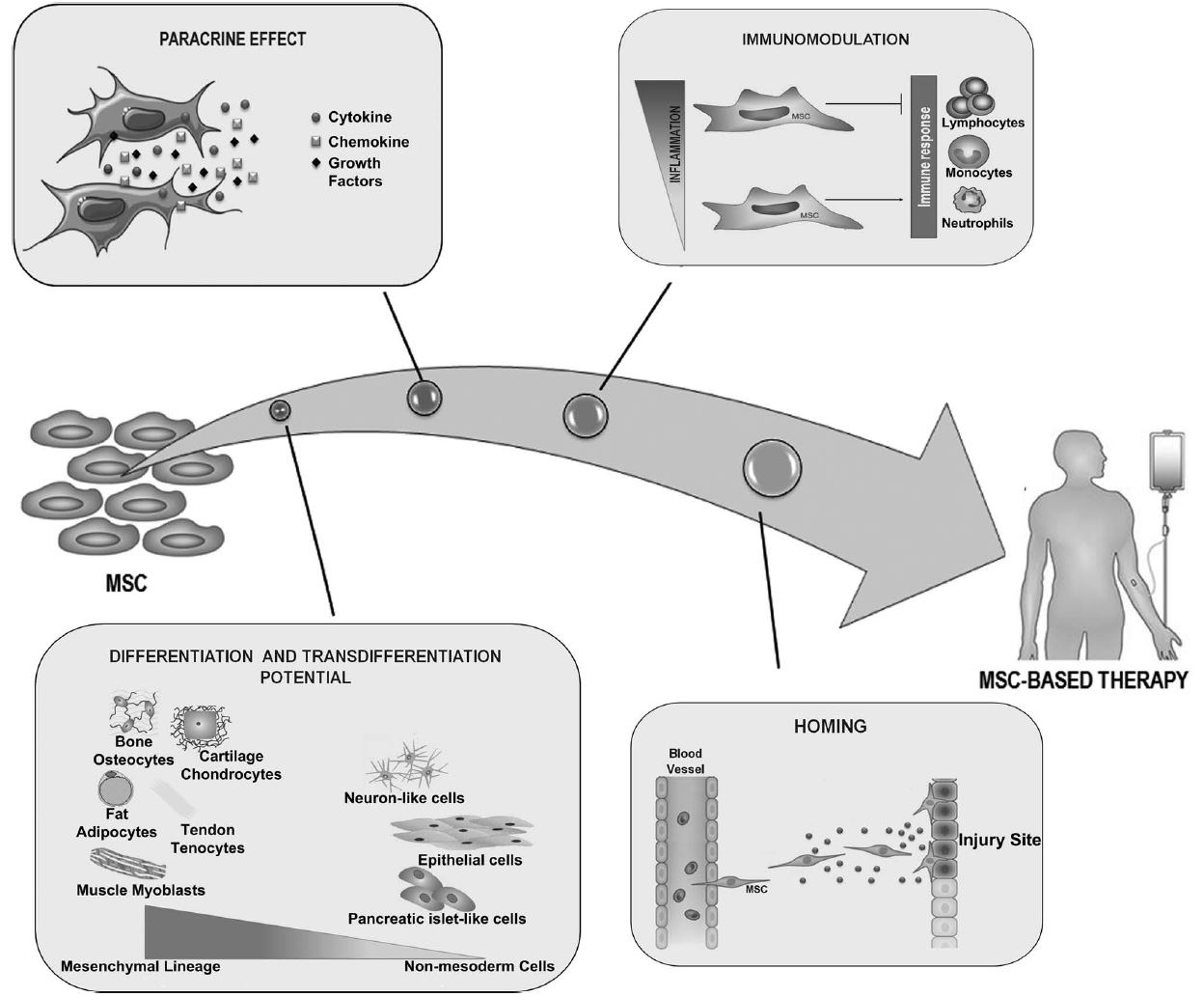間充質干細胞 (MSC) 是最著名的醫學干細胞類型之一。它們已被證明對范圍廣泛的疾病有效,而且風險很小。
與此同時,數百項臨床研究正在進行中,以更詳細地研究它們的再生能力。從生物學的角度來看,它們是結締組織的祖細胞。這意味著它們對于建立和維持全身結締組織的健康狀態很重要,被稱為基質干細胞。
同樣,它們具有分化成一系列其他細胞類型的能力,包括軟骨細胞(軟骨細胞)、成骨細胞(骨細胞)、脂肪細胞(脂肪細胞)等。這種特性將它們歸類為“多能干細胞”(能夠轉化為多種細胞類型)。
為什么間充質干細胞具有如此大的治療潛力?

為什么MSEC-間充質干細胞-與其他干細胞類型相比更常用
它們之所以成為醫學應用和人體臨床試驗中的主要干細胞類型,有以下幾個原因:
- 它們相對容易收獲并與以下隔離:
- 脂肪組織,稱為adMSC(脂肪來源的 MSC)
- 骨髓,稱為bmMSCs(骨髓間充質干細胞)
- 臍帶,稱為ucMSC(臍帶間充質干細胞)
- MSC在實驗室培養和擴增相對穩定
- 它們可以經歷相對較多的分裂周期而不會失去表達譜、健康和分裂潛能
- 為各種疾病模型收集的大量動物、臨床和科學數據,包括神經退行性疾病
- 它們幾乎沒有生長成癌細胞的潛力
- 正如最近的研究所揭示的那樣,它們的干細胞分泌蛋白組特征非常有益,因為它對身體顯示出廣泛的再生和保護能力
- 因此,MSC是我們制造干細胞分泌療法的最佳來源。
從脂肪組織中分離出的間充質干細胞
脂肪組織含有相對高濃度的間充質干細胞。通過酶法或顯微鏡去除非細胞部分來處理組織。這種細胞終產物稱為基質血管分數 (SVF)。用SVF治療可以有效治療某些區域和疾病。然而,它包含的MSC數量是有限的。MSC的擴增(在實驗室中增加它們的細胞計數)相對簡單。然而,這個過程極大地復雜化了臨床應用,因為它也會影響風險狀況。由于這個事實,這個過程在所有發達國家都受到高度限制。獲得更多MSC 的好處與獲得高細胞數無關,而是與它們的活力和分泌情況有關。

為什么間充質干細胞具有如此大的治療潛力?

如1) 分化成各種細胞譜系的能力,
2) 分泌旁分泌因子以啟動周圍細胞愈合和再生的能力,
3) 減少炎癥和調節免疫反應的能力,
4) 遷移到準確損傷部位的能力。圖來自 [10]。
參考資料:
- Gu W, Zhang F, Xue Q, Ma Z, Lu P, Yu B. Transplantation of bone marrow mesenchymal stem cells reduces lesion volume and induces axonal regrowth of injured spinal cord. Neuropathology. 2010; 30: 205-217.
- Wilkins A, Kemp K, Ginty M, Hares K, Mallam E, Scolding N. Human bone marrow-derived mesenchymal stem cells secrete brain-derived neurotrophic factor which promotes neuronal survival in vitro. Stem Cell Res. 2009; 3: 6370
- Wei X, Yang X, Han ZP, Qu FF, Shao L, Shi YF. Mesenchymal stem cells: a new trend for cell therapy. Acta Pharmacol Sin. 2013; 34: 747-754.
- Wang S, Qu X, Zhao RC. Clinical applications of mesenchymal stem cells. J Hematol Oncol. 2014; 5: 19.
- Farini, Andrea, et al. “Clinical applications of mesenchymal stem cells in chronic diseases.” Stem cells international 2014 (2014).
- Volarevic, Vladislav, et al. “Concise review: therapeutic potential of mesenchymal stem cells for the treatment of acute liver failure and cirrhosis.” Stem Cells 32.11 (2014): 2818-2823.
- Ikebe, Chiho, and Ken Suzuki. “Mesenchymal stem cells for regenerative therapy: optimization of cell preparation protocols.” BioMed research international 2014 (2014).
- Sharma, Ratti Ram, et al. “Mesenchymal stem or stromal cells: a review of clinical applications and manufacturing practices.” Transfusion 54.5 (2014): 1418-1437.
- Jo, Chris Hyunchul, et al. “Intra‐articular injection of mesenchymal stem cells for the treatment of osteoarthritis of the knee: a proof‐of‐concept clinical trial.” Stem cells 32.5 (2014): 1254-1266.
- Squillaro, Tiziana, Gianfranco Peluso, and Umberto Galderisi. “Clinical trials with mesenchymal stem cells: an update.” Cell transplantation 25.5 (2016): 829-848.
- Orozco, Lluis, et al. “Treatment of knee osteoarthritis with autologous mesenchymal stem cells: two-year follow-up results.” Transplantation 97.11 (2014): e66-e68.
- Filardo, Giuseppe, et al. “Mesenchymal stem cells for the treatment of cartilage lesions: from preclinical findings to clinical application in orthopaedics.” Knee surgery, sports traumatology, arthroscopy 21.8 (2013): 1717-1729.
- Jo, Chris Hyunchul, et al. “Intra‐articular injection of mesenchymal stem cells for the treatment of osteoarthritis of the knee: a proof‐of‐concept clinical trial.” Stem cells 32.5 (2014): 1254-1266.
- Vangsness, C. Thomas, et al. “Adult human mesenchymal stem cells delivered via intra-articular injection to the knee following partial medial meniscectomy.” J Bone Joint Surg Am 96.2 (2014): 90-98.
- Pires A.O., Mendes-Pinheiro B., Teixeira F.G., Anjo S.I., Ribeiro-Samy S., Gomes E.D., Serra S.C., Silva N.A., Manadas B., Sousa N., et al. Unveiling the Differences of Secretome of Human Bone Marrow Mesenchymal Stem Cells, Adipose Tissue-Derived Stem Cells, and Human Umbilical Cord Perivascular Cells: A Proteomic Analysis. Stem Cells Dev. 2016;25:1073–1083. doi: 10.1089/scd.2016.0048.
免責說明:本文僅用于傳播科普知識,分享行業觀點,不構成任何臨床診斷建議!杭吉干細胞不保證信息的準確性和完整性。所發布的信息不能替代醫生或藥劑師的專業建議。如有版權等疑問,請隨時聯系我。
標簽: 間充質干細胞




 掃碼添加微信
掃碼添加微信